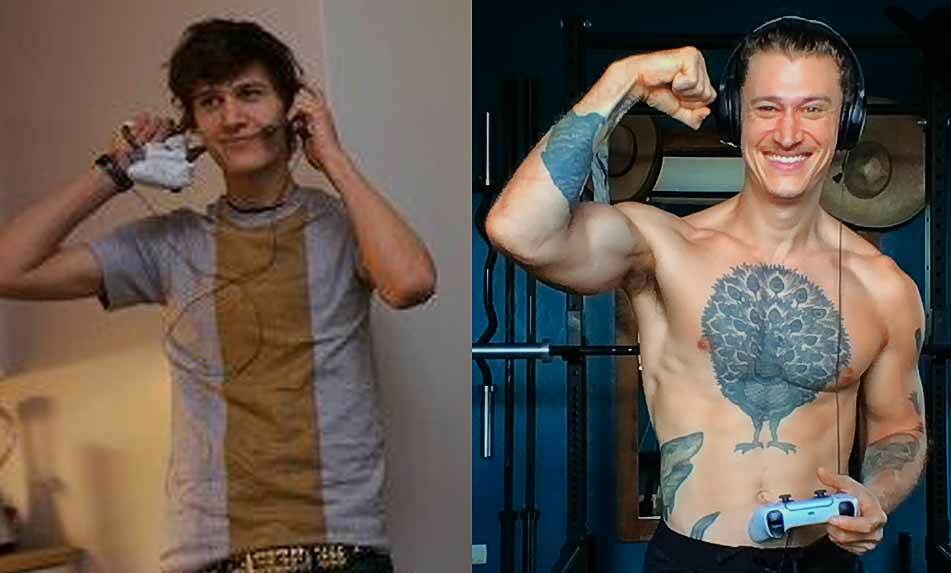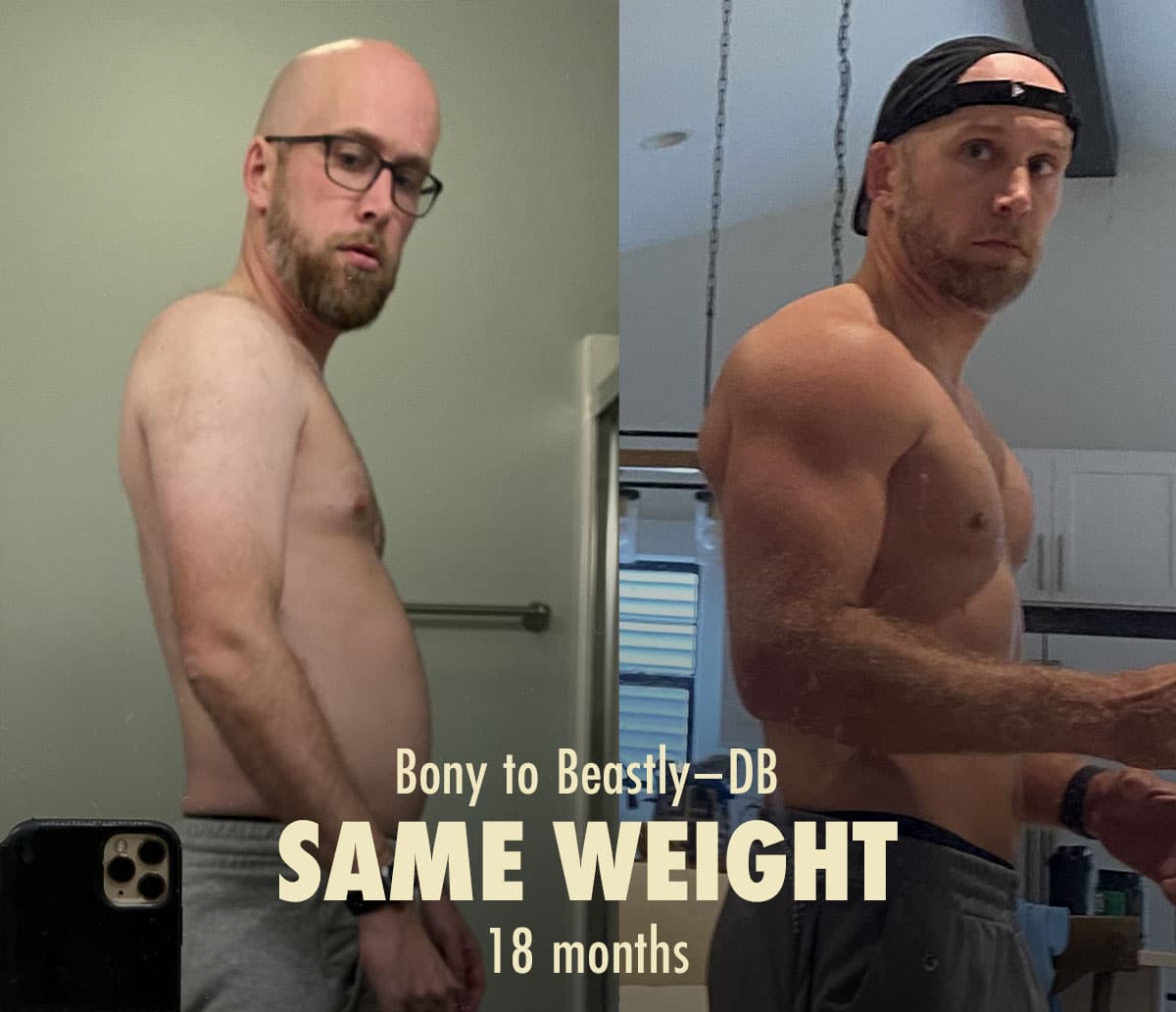Natural Muscular Potential Calculator
Maximum Body Weight & Measurements
How to Measure Your Bones
The calculator runs on a few different measurements. Your height affects how much you'll weigh at your genetic potential. Your wrists and ankles determine how big you can build your muscles.
The reason we use your wrists and ankles is because there's very little muscle and fat there. They're almost entirely bone and tendon. That makes it really easy to measure how thick your bones are compared to the average man.
- Wrist Circumference: Measure just above the lump of your wrist bone, next to your hand. 7 inches is average.
- Ankle Circumference: Measure around the smallest point of the ankle. 8.8 inches is average.
Notice that your height doesn't affect your maximum measurements. For example, I'm taller than average (6'2) but have thinner wrists than average (6.75 inches), so my maximum arm size (16 inches) is smaller than average.
Here I am with 16-inch arms. I suspect I can get them bigger:
Fortunately, the measurements that suit you the best scale with your bone size, too. That means that almost everyone has the genetic potential to look great. We have a separate calculator for aesthetics.
Goal Body Fat Percentage
Your goal body fat percentage affects your weight and measurements. Fat contains lean mass, it's heavy, and it takes up space. Thus, the more fat you're carrying, the more you'll weigh and the bigger your measurements will be. Plus, being fatter makes it easier to build more muscle (full explanation).
I recommend using 12% as your goal body fat percentage, but the formula works well from 4–12% body fat. That doesn't mean you need to get down to 12% body fat to look good or be healthy. It's just that bodybuilders tend to get measured right before their competitions, so most of that data comes from guys who are "stage lean."
You can use a higher body fat percentage, but the calculator won't be as accurate, so take the results with a pinch of salt.
- 4% body fat: chiselled everything, striated glutes.
- 8% body fat: chiselled abs.
- 12% body fat: faintly visible abs.
- 15% body fat: flat stomach, maybe some upper abs.
- 22% body fat: flat stomach, maybe some love handles.
Most women find men most attractive when they're between 10–15% body fat (full explanation). You'll probably be healthiest with a body-fat percentage of 8–22% (study) and a waist circumference under 36–40 inches (study).
How to Measure Your Muscles
The best way to measure your muscles is to take body-part circumference measurements. Bodybuilders usually track these ones:
- Neck: Below the Adam's apple at the smallest point. Head held high and relaxed. The average man has a neck circumference of 15 inches.
- Shoulders: Measure all the way around your shoulders at the widest point. I'm not sure of the average man's shoulder circumference, but the average soldier has a shoulder circumference of 46 inches (study).
- Chest: The fullest part of the chest, usually at nipple level. Keep your chest relaxed and arms at your sides. Don't flex your lats or take a deep breath. 39 inches is average.
- Biceps: Flexed and measured at the highest peak. Measured "cold"—without a muscle pump. 13 inches is average.
- Forearms: The largest point of your forearm with your fist clenched and your wrist straight. 12 inches is average.
- Waist: At the height of your belly button, standing tall, relaxed. Don't take a deep breath or suck in. 40 inches is average.
- Thighs: Halfway between the hip and knee. Leg muscles relaxed. 22 inches is average.
- Calves: Flexed and measured at the largest point, with your heels on the floor. 14 inches is average.
The calculator will estimate how big you can get those measurements if you have average bodybuilding genetics. If you suspect you have poor genetics, look at the lower end of the range in parentheses. If you suspect you have great genetics, look at the top of that range.
There isn't an ideal waist circumference. If you train your abs, obliques, lower back, and postural muscles, your waist will grow thick and strong. If you get down to a lean body-fat percentage (8–15%), then it will be lean and chiselled.
If your waist is blockier, you probably have better muscle-building genetics. If your waist is leaner, it will contrast nicely with your legs and shoulders. It can be good either way. Even in bodybuilding, there are revered champions with both thick and narrow waists.
Muscle-Building Mini-Course via Email
Sign up for our 5-part muscle-building mini-course that covers everything you need to know about:
- Hardgainer genetics and how to make the most of them.
- How to take a minimalist approach to building muscle while still getting great results.
- What you need to know about aesthetics, health and strength while muscling up.
How the Formulas Work
This calculator uses the formulas from the most recent (4th) edition of Dr. Casey Butt's book, Your Muscular Potential. He came up it after studying hundreds of natural bodybuilders, strength athletes, and regular gym goers. He also included data from the era before bodybuilders started using steroids.
Dr. Butt found that people with thicker, broader bone structures were able to build more muscle. Modern research backs this up (study, study). You can think of your skeleton like a bookshelf. The taller, broader, and sturdier it is, the more books it can support, so the more books your body will be willing to pile upon it.
The easiest way to measure the thickness of your bones is to measure where you're the boniest: your wrists and ankles. Those measurements give us clues about your overall bone structure, allowing us to guess at your genetic muscular potential.
None of this is controversial. Almost everyone who talks about genetic muscular potential refers back to Dr. Butt. He's the undisputed expert. Most calculators use these same formulas. This one uses the latest formulas from the 4th edition of his book.
Your Natural Muscular Potential
This calculator is designed for natural lifters. That's who Dr. Butt was interested in. That's who we're interested in. But it raises a potential problem: it's hard to tell who's natural.
Bodybuilders and strength athletes both have incentives to claim natural, even if they aren't. So, Dr. Butt looked at measurements from before bodybuilders started using steroids, gathering data from the 1950s and 60s. He then compared those against modern natural bodybuilders (including well-known natural bodybuilders like Dr. Layne Norton).
I'm a natural lifter, and I've been coaching natural lifters for nearly 15 years. These measurements all seem realistic to me. I'm tall, naturally thin, and have very slender bones. Several years of bulking up have brought my measurements up to about where they should be.
In fact, Dr. Butt is often accused of being too conservative, of giving estimates that are too small. That may be true.
I spoke with Dr. Butt, and he told me that my bones are unusually thin for my height, so it's possible that the formulas are underestimating my natural muscular potential. My bones are indeed thin compared to most bodybuilders, but if you're naturally thin, you might not be so different. It's fairly common in our community.
Can You Increase Your Bone Thickness & Wrist Circumference?
One of the questions skinny guys (like me) usually ask is whether it's possible to thicken up our narrow bones. I don't think it is, at least not by very much. I've never seen a good example of it. I've never read any convincing research.
I've been lifting weights for 10 years, gone from 130 to 200 pounds, brought my bench press from 60 to 315 pounds, and deadlifted 405 pounds for a set of 10 reps. After all that, my wrist circumference went from just over 6.5 inches to just under 6.75 inches. It's such a small increase that it's probably just a measurement error.
It's possible that punching things or doing strange forearm routines would bulk up your wrist circumference even more, but I'm not sure if that would increase your natural muscular potential. For that, you'd presumably need to bulk up all of your bones.
It is possible to increase your bone density, though. Your bones might not get bigger, but they can certainly get tougher and heavier. It's possible that denser bones could support more muscle mass. I'm not sure, but it's scientifically plausible.
How to Build Muscle & Burn Fat
Most guys can improve their appearance by building muscle, burning fat, or doing some combination of the two. That gives you three paths you can take toward your genetic muscular potential:
- Bulking is the fastest and most reliable way to build muscle. It's when you train for muscle growth, eat a nutritious muscle-building diet, and eat enough food to gain a little bit of weight on the scale each week. It becomes increasingly important as you get more advanced.
- Cutting is the fasted and most reliable way to burn fat. It's when you train for muscle growth, eat a balanced diet, and dip into a calorie deficit, forcing your body to get energy from your body fat. It becomes increasingly necessary as you get leaner.
- Recomping is when you try to build muscle and burn fat at the same time, usually without focusing on gaining or losing weight. It works best for people who are overweight, out of shape, and not in the habit of lifting weights. When you stop gaining strength in the gym, you can improve your methods and train more vigorously. When that stops working, it's time to start bulking or cutting.
If you have a healthy body fat percentage (waist circumference under 36 inches), then the best way to reach your genetic potential is to bulk as leanly as you can for as long as you can. If you're a skinny beginner, you might be able to bulk more aggressively. As you get more advanced, you'll probably want to slow down, sticking to lean bulks.
You can take breaks to cut away the fat, but it's better to keep your gains lean enough that you don't need to spend very much time cutting.
You can cut down to a lean body fat percentage whenever you want. It can be fun to get lean. But getting much leaner than 10–12% can be hard, and the fat might come right back as soon as you start trying to build muscle again.
Once you're reasonably muscular, you can focus even more on certain muscles and proportions. For example, if your arms are falling behind, you could do an arm specialization program to bring them up.
The Bony to Beastly Program
If you want a full fat loss and muscle-building program, including a 5-month workout routine, a diet guide, a recipe book, and online coaching, check out our Bony to Beastly Bulking Program. Or, if you want a customizable intermediate hypertrophy program, check out our Outlift Program. You can use either of these programs for bulking, cutting, or recomping.
Alright, that’s it for now. If you made it this deep into the article, you might like our newsletter.




